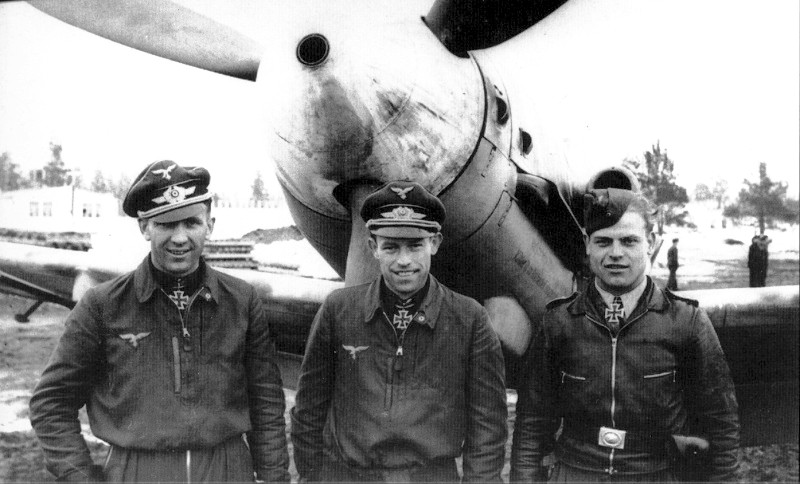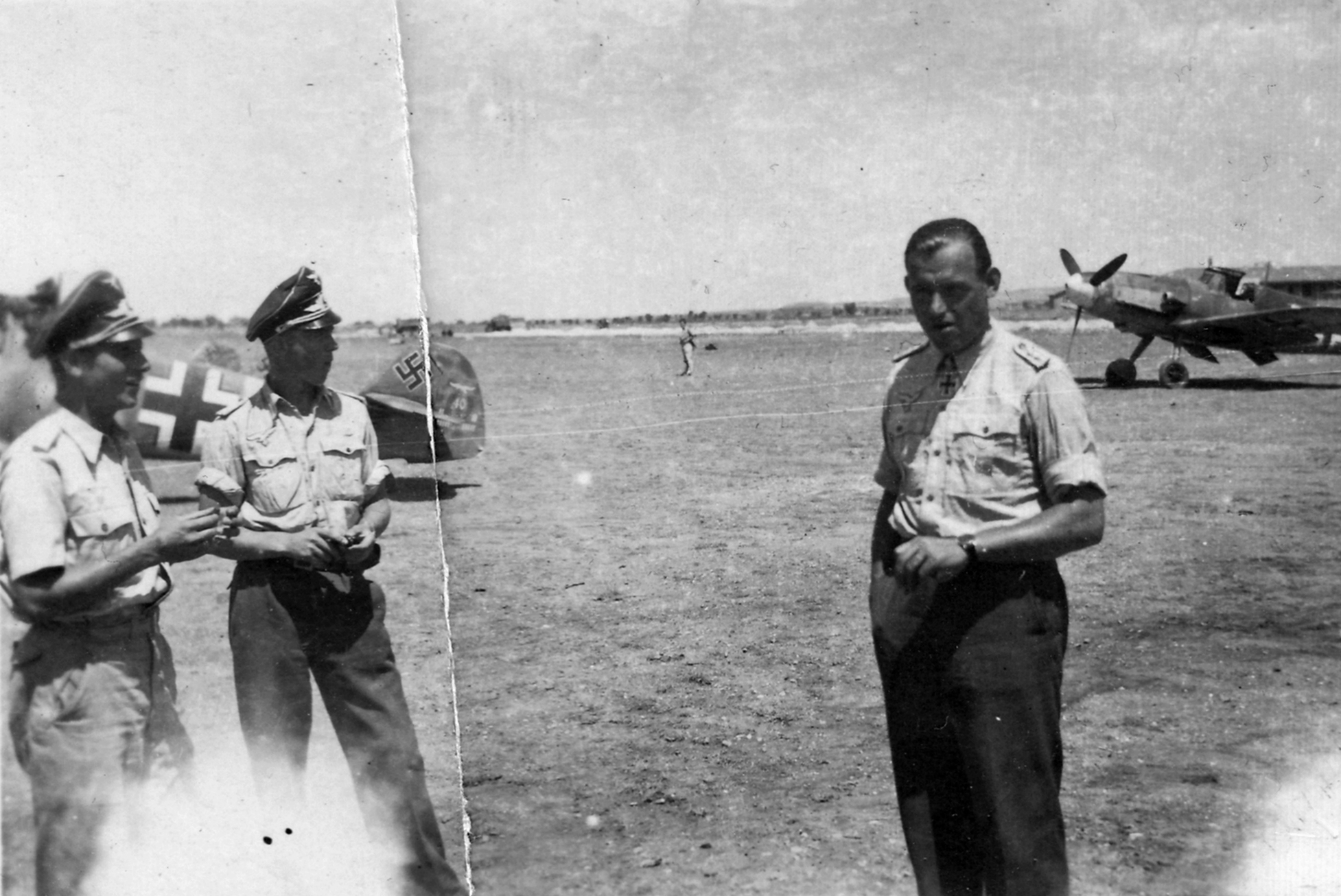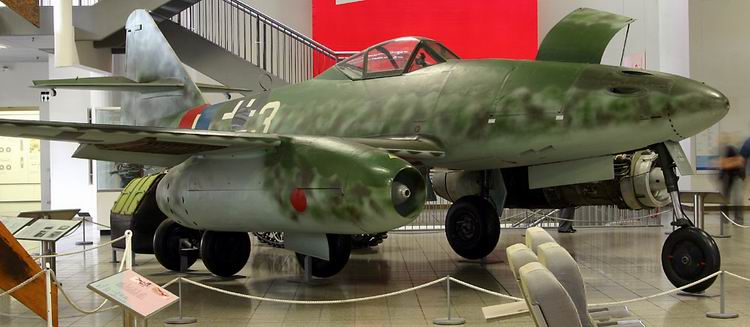|
Heinrich Ehrler
Heinrich Ehrler (14 September 1917 – 4 April 1945) was a German Luftwaffe military aviator and wing commander during World War II. As a fighter ace, he is credited with 208 enemy aircraft shot down in over 400 combat missions. The majority of his victories were claimed over the Eastern Front, with nine claims over the Western Front which included eight in the Messerschmitt Me 262 jet fighter. Born in Oberbalbach, Ehrler grew up in the Weimar Republic and Nazi Germany as one of 12 children in his family. He joined the military service in the Wehrmacht in 1935, initially serving with the artillery and anti-aircraft artillery. He participated in the Spanish Civil War and following the outbreak of World War II transferred to the '' Jagdwaffe'' (fighter force). Following flight training, he was posted to the 4. '' Staffel'' of ''Jagdgeschwader'' 77 (JG 77–77th Fighter Wing), and later reassigned to 4. ''Staffel'' of ''Jagdgeschwader'' 5 (JG 5–5th Fighter Wing). ... [...More Info...] [...Related Items...] OR: [Wikipedia] [Google] [Baidu] |
Lauda-Königshofen
Lauda-Königshofen is a town in the Main-Tauber district in Baden-Württemberg, Germany. It is situated on the river Tauber, 7 km southeast of Tauberbischofsheim, and 30 km southwest of Würzburg. Most of the roughly 300 houses in the traditional village of Königshofen date to between the 16th century and mid-19th century, and it is known for the 500+ year-old Königshöfer Messe, an annual festival that attracts 150,000 people over the 10-day festival. Lauda station is at a junction of the Franconia Railway and the Tauber Valley Railway. Districts The 12 districts with population (as of 2001): Area in km² (as in 2006) Twin towns * Boissy-Saint-Léger (France) * Paks (Hungary) * Rátka (Hungary) Sports * FV Lauda, soccer * Lauda Hornets, American football Notable natives * Johann Gottfried von Aschhausen, (1575–1622), Bishop of diocese Würzburg and Archbishopric of Bamberg * Johann Rudolf Zumsteeg, (1760–1802), composer * Johann Martin Schleyer, (1831–19 ... [...More Info...] [...Related Items...] OR: [Wikipedia] [Google] [Baidu] |
Knight's Cross Of The Iron Cross With Oak Leaves
The Knight's Cross of the Iron Cross (german: Ritterkreuz des Eisernen Kreuzes), or simply the Knight's Cross (), and its variants, were the highest awards in the military and paramilitary forces of Nazi Germany during World War II. The Knight's Cross was awarded for a wide range of reasons and across all ranks, from a senior commander for skilled leadership of his troops in battle to a low-ranking soldier for a single act of military valour. Presentations were made to members of the three military branches of the : the (army), the (navy) and the (air force), as well as the , the Reich Labour Service and the (German People storm militia), along with personnel from other Axis powers. The award was instituted on 1 September 1939, at the onset of the German invasion of Poland. The award was created to replace the many older merit and bravery neck awards of the German Empire. A higher grade, the Oak Leaves to the Knight's Cross, was instituted in 1940. In 1941, two higher grades ... [...More Info...] [...Related Items...] OR: [Wikipedia] [Google] [Baidu] |
Jagdgeschwader 77
''Jagdgeschwader'' 77 (JG 77) ''Herz As'' ("Ace of Hearts") was a Luftwaffe fighter wing during World War II. It served in all the German theaters of war, from Western Europe to the Eastern Front, and from the high north in Norway to the Mediterranean. All three ''gruppen'' (groups) within the unit operated variants of the Messerschmitt Bf 109. II. Gruppe was the only German unit entirely equipped, albeit only during November–December 1943, with the Macchi C.205, a highly regarded Italian fighter. Formation Initially, JG 77 was created with two ''Gruppen'' (groups) and without a ''Geschwaderstab'' (headquarters unit). I. ''Gruppe'' of JG 77 was created from IV. ''Gruppe'' of ''Jagdgeschwader'' 132 (JG 132—132nd Fighter Wing), which had become I. ''Gruppe'' of ''Jagdgeschwader'' 331 (JG 331—331st Fighter Wing) on 3 November 1938 before it was renamed to I. ''Gruppe'' of JG 77 on 1 May 1939. II. ''Gruppe'' of JG 77 was derived from one of the ... [...More Info...] [...Related Items...] OR: [Wikipedia] [Google] [Baidu] |
Organization Of The Luftwaffe (1933–1945)
Between 1933 and 1945, the organization of the Luftwaffe underwent several changes. Originally, the German military high command, for their air warfare forces, decided to use an organizational structure similar to the army and navy, treating the aviation branch as a strategic weapon of war. Later on, during the period of rapid rearmament, the Luftwaffe was organized more in a geographical fashion. Under the terms of the Treaty of Versailles (1919), Germany was prohibited from having an air force, with the former German Empire's ''Luftstreitkräfte'' disbandment in 1920. German pilots were secretly trained for military aviation, first in the Soviet Union during the late 1920s, and then in Germany in the early 1930s. In Germany, the training was done under the guise of the German Air Sports Association (german: Deutscher Luftsportverband (DLV)) at the Central Commercial Pilots School (german: Zentrale der Verkehrs Fliegerschule (ZVF)). Following its 15 May 1933 formation in secret, ... [...More Info...] [...Related Items...] OR: [Wikipedia] [Google] [Baidu] |
Jagdwaffe
''Jagdwaffe'' (german: Fighter Force), was the German ''Luftwaffes fighter force during World War II. Aircraft The ''Jagdwaffe'' used many aircraft, including the Messerschmitt Bf 109, Bf 110, Me 163, Me 262, Focke-Wulf Fw 190, Ta 152, and Heinkel He 162. References * Further reading *Luftwaffe Organization The ''Luftwaffe'' () was the aerial-warfare branch of the German ''Wehrmacht'' before and during World War II. Germany's military air arms during World War I, the ''Luftstreitkräfte'' of the Imperial Army and the '' Marine-Fliegerabtei ... Military units and formations of the Luftwaffe {{germany-mil-unit-stub ... [...More Info...] [...Related Items...] OR: [Wikipedia] [Google] [Baidu] |
Anti-aircraft Artillery
Anti-aircraft warfare, counter-air or air defence forces is the battlespace response to aerial warfare, defined by NATO as "all measures designed to nullify or reduce the effectiveness of hostile air action".AAP-6 It includes surface based, subsurface ( submarine launched), and air-based weapon systems, associated sensor systems, command and control arrangements, and passive measures (e.g. barrage balloons). It may be used to protect naval, ground, and air forces in any location. However, for most countries, the main effort has tended to be homeland defence. NATO refers to airborne air defence as counter-air and naval air defence as anti-aircraft warfare. Missile defence is an extension of air defence, as are initiatives to adapt air defence to the task of intercepting any projectile in flight. In some countries, such as Britain and Germany during the Second World War, the Soviet Union, and modern NATO and the United States, ground-based air defence and air defence aircraft ... [...More Info...] [...Related Items...] OR: [Wikipedia] [Google] [Baidu] |
Artillery
Artillery is a class of heavy military ranged weapons that launch munitions far beyond the range and power of infantry firearms. Early artillery development focused on the ability to breach defensive walls and fortifications during sieges, and led to heavy, fairly immobile siege engines. As technology improved, lighter, more mobile field artillery cannons developed for battlefield use. This development continues today; modern self-propelled artillery vehicles are highly mobile weapons of great versatility generally providing the largest share of an army's total firepower. Originally, the word "artillery" referred to any group of soldiers primarily armed with some form of manufactured weapon or armor. Since the introduction of gunpowder and cannon, "artillery" has largely meant cannons, and in contemporary usage, usually refers to shell-firing guns, howitzers, and mortars (collectively called ''barrel artillery'', ''cannon artillery'', ''gun artillery'', or - a layman t ... [...More Info...] [...Related Items...] OR: [Wikipedia] [Google] [Baidu] |
Wehrmacht
The ''Wehrmacht'' (, ) were the unified armed forces of Nazi Germany from 1935 to 1945. It consisted of the ''Heer'' (army), the ''Kriegsmarine'' (navy) and the ''Luftwaffe'' (air force). The designation "''Wehrmacht''" replaced the previously used term and was the manifestation of the Nazi regime's efforts to rearm Germany to a greater extent than the Treaty of Versailles permitted. After the Nazi rise to power in 1933, one of Adolf Hitler's most overt and audacious moves was to establish the ''Wehrmacht'', a modern offensively-capable armed force, fulfilling the Nazi régime's long-term goals of regaining lost territory as well as gaining new territory and dominating its neighbours. This required the reinstatement of conscription and massive investment and defense spending on the arms industry. The ''Wehrmacht'' formed the heart of Germany's politico-military power. In the early part of the Second World War, the ''Wehrmacht'' employed combined arms tactics (close-cover ... [...More Info...] [...Related Items...] OR: [Wikipedia] [Google] [Baidu] |
Weimar Republic
The Weimar Republic (german: link=no, Weimarer Republik ), officially named the German Reich, was the government of Germany from 1918 to 1933, during which it was a constitutional federal republic for the first time in history; hence it is also referred to, and unofficially proclaimed itself, as the German Republic (german: Deutsche Republik, link=no, label=none). The state's informal name is derived from the city of Weimar, which hosted the constituent assembly that established its government. In English, the republic was usually simply called "Germany", with "Weimar Republic" (a term introduced by Adolf Hitler in 1929) not commonly used until the 1930s. Following the devastation of the First World War (1914–1918), Germany was exhausted and sued for peace in desperate circumstances. Awareness of imminent defeat sparked a revolution, the abdication of Kaiser Wilhelm II, formal surrender to the Allies, and the proclamation of the Weimar Republic on 9 November 1918. In its i ... [...More Info...] [...Related Items...] OR: [Wikipedia] [Google] [Baidu] |
Messerschmitt Me 262
The Messerschmitt Me 262, nicknamed ''Schwalbe'' (German: "Swallow") in fighter versions, or ''Sturmvogel'' (German: "Storm Bird") in fighter-bomber versions, is a fighter aircraft and fighter-bomber that was designed and produced by the German aircraft manufacturer Messerschmitt. It was the world's first operational jet-powered fighter aircraft. The initial design of what would become the Me 262 started in April 1939, prior to the start of the Second World War. While the aircraft performed its maiden flight on 18 April 1941, this was using piston engine instead of jet propulsion; it was not until 18 July 1942 that the first jet-powered flight was performed. Progress on the project was delayed by problems with engines, metallurgy and top-level interference from figures such as Hermann Göring, head of the Luftwaffe, and Adolf Hitler. The latter advocated from the Me 262 to be operated as a ground-attack/bomber aircraft rather than a defensive interceptor, thus necessitating a ... [...More Info...] [...Related Items...] OR: [Wikipedia] [Google] [Baidu] |
Western Front (World War II)
The Western Front was a European theatre of World War II, military theatre of World War II encompassing Denmark, Norway, Luxembourg, Belgium, Netherlands, the Netherlands, the United Kingdom, France, and Germany. The Italian campaign (World War II), Italian front is considered a separate but related theater. The Western Front's 1944-1945 phase was officially deemed the European Theater of Operations, United States Army, European Theater by the United States, whereas Italy fell under the Mediterranean Theater of Operations, United States Army, Mediterranean Theater along with North Africa. The Western Front was marked by two phases of large-scale combat operations. The first phase saw the capitulation of Luxembourg, Netherlands, Belgium, and France during May and June 1940 after their defeat in the Low Countries and the northern half of France, and continued into an air war between Germany and Britain that climaxed with the Battle of Britain. The second phase consisted of large- ... [...More Info...] [...Related Items...] OR: [Wikipedia] [Google] [Baidu] |
Fighter Ace
A flying ace, fighter ace or air ace is a military aviator credited with shooting down five or more enemy aircraft during aerial combat. The exact number of aerial victories required to officially qualify as an ace is varied, but is usually considered to be five or more. The concept of the "ace" emerged in 1915 during World War I, at the same time as aerial dogfighting. It was a propaganda term intended to provide the home front with a cult of the hero in what was otherwise a war of attrition. The individual actions of aces were widely reported and the image was disseminated of the ace as a chivalrous knight reminiscent of a bygone era. For a brief early period when air-to-air combat was just being invented, the exceptionally skilled pilot could shape the battle in the skies. For most of the war, however, the image of the ace had little to do with the reality of air warfare, in which fighters fought in formation and air superiority depended heavily on the relative availability ... [...More Info...] [...Related Items...] OR: [Wikipedia] [Google] [Baidu] |








